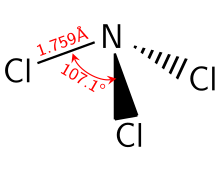

This article needs additional citations for verification. Please help improve this articlebyadding citations to reliable sources. Unsourced material may be challenged and removed.
Find sources: "Nitrogen trichloride" – news · newspapers · books · scholar · JSTOR (May 2023) (Learn how and when to remove this message) |

| |

Nitrogen, N
Chlorine, Cl
| |

| |
| Names | |
|---|---|
| Other names
Trichloramine | |
| Identifiers | |
3D model (JSmol) |
|
| ChEBI | |
| ChemSpider |
|
| ECHA InfoCard | 100.030.029 |
| EC Number |
|
| 1840 | |
PubChem CID |
|
| RTECS number |
|
| UNII | |
CompTox Dashboard (EPA) |
|
| |
| |
| Properties | |
| NCl3 | |
| Molar mass | 120.36 g·mol−1 |
| Appearance | yellow oily liquid |
| Odor | chlorine-like |
| Density | 1.653 g/mL |
| Melting point | −40 °C (−40 °F; 233 K) |
| Boiling point | 71 °C (160 °F; 344 K) |
| immiscible slowly decomposes | |
| Solubility | soluble in benzene, chloroform, CCl4, CS2, PCl3 |
| Structure | |
| orthorhombic (below −40 °C) | |
| trigonal pyramidal | |
| 0.6 D | |
| Thermochemistry | |
Std enthalpy of |
232 kJ/mol |
| Hazards | |
| NFPA 704 (fire diamond) | |
| 93 °C (199 °F; 366 K) | |
| Related compounds | |
Other anions |
Nitrogen trifluoride Nitrogen tribromide Nitrogen triiodide |
Other cations |
Phosphorus trichloride Arsenic trichloride |
Related chloramines |
Monochloramine Dichloramine |
Related compounds |
Nitrosyl chloride |
Except where otherwise noted, data are given for materials in their standard state (at 25 °C [77 °F], 100 kPa). | |
Nitrogen trichloride, also known as trichloramine, is the chemical compound with the formula NCl3. This yellow, oily, and explosive liquid is most commonly encountered as a byproduct of chemical reactions between ammonia-derivatives and chlorine (for example, in swimming pools). Alongside monochloramine and dichloramine, trichloramine is responsible for the distinctive 'chlorine smell' associated with swimming pools, where the compound is readily formed as a product from hypochlorous acid reacting with ammonia and other nitrogenous substances in the water, such as urea from urine.[1]
The compound is prepared by treatment of ammonium salts, such as sal ammoniac with a chlorine source.
Intermediates in this conversion include monochloramine and dichloramine, NH2Cl and NHCl2, respectively.
Like ammonia, NCl3 is a pyramidal molecule. The N-Cl distances are 1.76 Å, and the Cl-N-Cl angles are 107°.[2]
The chemistry of NCl3 has been well explored.[3] It is moderately polar with a dipole moment of 0.6 D. The nitrogen center is basic but much less so than ammonia. It is hydrolyzed by hot water to release ammonia and hypochlorous acid.




This reaction is inhibited for dilute gases.
Nitrogen trichloride can form in small amounts when public water supplies are disinfected with monochloramine, and in swimming pools by disinfecting chlorine reacting with urea in urine and sweat from bathers.
Nitrogen trichloride, trademarked as Agene, was at one time used to bleach flour,[4] but this practice was banned in the United States in 1949 due to safety concerns.
Nitrogen trichloride can irritate mucous membranes—it is a lachrymatory agent, but has never been used as such.[5][6] The pure substance (rarely encountered) is a dangerous explosive, being sensitive to light, heat, even moderate shock, and organic compounds. Pierre Louis Dulong first prepared it in 1812, and lost several fingers and an eye in two explosions.[7] In 1813, an NCl3 explosion blinded Sir Humphry Davy temporarily, inducing him to hire Michael Faraday as a co-worker. They were both injured in another NCl3 explosion shortly thereafter.[8]
{{cite book}}: |journal= ignored (help)|
Nitrogen species
| |
|---|---|
| Hydrides |
|
| Organic |
|
| Oxides |
|
| Halides |
|
| Oxidation states | |
|
| |
|---|---|
| Chlorides and acids |
|
| Chlorine fluorides |
|
| Chlorine oxides |
|
| Chlorine oxyfluorides |
|
| Chlorine(I) derivatives |
|
|
Salts and covalent derivatives of the nitride ion
| ||||||||||||||||||||||||||||||||||||||||||||||||||||||||||||||||||||||||||||||||||||||||||||||||||||||||||||||||||||||||||||||||||||||||||||||||||||||||||||||||||||
|---|---|---|---|---|---|---|---|---|---|---|---|---|---|---|---|---|---|---|---|---|---|---|---|---|---|---|---|---|---|---|---|---|---|---|---|---|---|---|---|---|---|---|---|---|---|---|---|---|---|---|---|---|---|---|---|---|---|---|---|---|---|---|---|---|---|---|---|---|---|---|---|---|---|---|---|---|---|---|---|---|---|---|---|---|---|---|---|---|---|---|---|---|---|---|---|---|---|---|---|---|---|---|---|---|---|---|---|---|---|---|---|---|---|---|---|---|---|---|---|---|---|---|---|---|---|---|---|---|---|---|---|---|---|---|---|---|---|---|---|---|---|---|---|---|---|---|---|---|---|---|---|---|---|---|---|---|---|---|---|---|---|---|---|---|
| ||||||||||||||||||||||||||||||||||||||||||||||||||||||||||||||||||||||||||||||||||||||||||||||||||||||||||||||||||||||||||||||||||||||||||||||||||||||||||||||||||||